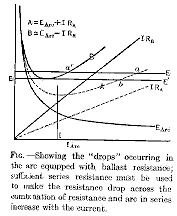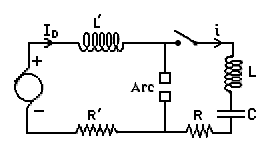A Working Poulsen Arc Oscillator
Revisiting A Longwave Transmitting Classic
|
The Problem Suppose you're trying to invent radio. You realize sparks will produce electromagnetic waves, so you establish an industry based on that fact. But sparks produce damped waves...very noisy, occupying way too much spectrum, and totally unsuited for voice. How will you produce clean, steady, undamped oscillations, so more stations can be on the air, and perhaps even (gasp!) transmit audio? And, how can you do all this before the invention of powerful vacuum tubes? Mechanically-driven generators can obviously produce alternating current, so it was logical to extend them to even higher frequencies. Ernst Alexanderson followed this approach with great success, but alternators were most practical at high power levels, and frequencies of 100 kHz or less. Might there be other ways to generate continuous undamped waves? Something more portable, perhaps; and, capable of higher frequencies, where lower power levels can communicate across great distances. From Singing Flames to Global Communication In the earliest days of the Twentieth Century, electric arcs between carbon rods were a significant method for producing large amounts of white light. They were used at various times for street lighting, searchlights, spotlights, making negatives and plates for offset printing, and in motion picture projection.
As it turns out, a negative resistance device is not something you want to stick straight across a power line. Unless a ballast of some sort is used, the current will quickly run away, producing a dead short. Purely resistive ballasts work, but are too wasteful for widespread commercial application. Early investigators working on AC power systems realized that an inductor could also be used to limit current flow. We Herman Theodor Simon also extensively investigated the AC characteristics of arc flames, and we know that Valdemar Poulsen was familiar with Simon's studies. Poulsen was deliberately working to produce higher frequency oscillations, and had an LC circuit connected across carbon arc electrodes. Not much power resulted from these experiments, until he one day slid an alcohol-fueled "Spiritus" lamp under the open arc. He reported that the foils in his Leyden jar capacitors crackled, revealing that significant power was suddenly present in the system. With this vital clue about the role of gasses in the production of stable RF oscillations, and later discoveries about the role of magnetic fields, Poulsen created a viable alternative to alternators. Arc transmitters waned in importance during the Twenties, but arc oscillators continued to serve science into the early atomic era. And Today... Poulsen arc transmitters are an almost forgotten chapter in communications history. Almost! At least one experimenter hasn't forgotten about them. David L. Quinlan of Roseland, New Jersey, has built what may be the only operational Poulsen arc transmitter in the world! He has also developed an extensive library on the subject, and would like to hear from any readers who are interested in Poulsen arcs. He can be reached at poulsen@mail.hicom.net. David supplied most of the information and all the illustrations for this article. With his help, we hope to eventually add more articles and links on arc transmitter topics, so be sure to check this page again in the future! What follows are David's own words about the transmitter he constructed: Hello! If you are interested in Historic radiocommunications, perhaps you would be interested in my home made Poulsen Arc oscillator. This is only a table top sized arc but it has most of the features of the arcs used for world wide communications between 1903 and the 1930's.
I use a carbon/copper arc with about 10 amperes input to the arc. The carbons are graphite rods called air gouging carbons. They are made for welding use and are pure graphite. McMaster Carr sells them nationwide, I believe. Only the negative electrode is carbon. The other is massive copper, drilled out inside for water circulation. My arc doesn't make a lot of heat but I'm holding the anode together with lead solder. That works fine unless the flow of water is interrupted in which case the solder melts out of the anode and requires more fixin'. (The coils on either side of the arc chamber are part of a magnetic circuit that improves the efficiency of the oscillator.) The can on top is the reservoir for Alcohol! which is a necessity to make the arc oscillate. No alcohol = no oscillations, or only very weak ones. My alcohol reservoir was once a paper cement can; that's why it has writing on it. The alcohol is dripped into the flaming arc a few drops at a time. This was standard practice for the Poulsen system. One problem with this was that the alcohol kept disappearing on ships, for some rather obvious reason! So they switched to Kerosene and THAT never disappeared! As far as flammables, what is really wanted is hydrogen which diasssociates as H1. Fleming tried hydrogen from a tank but said it was very hard to keep the arc from going out. That was about 1910. After that everybody used alcohol or kerosene. Kerosene made electroconductive soot which caused flash overs inside the chamber and required maintainance to correct the problem. Some tried ether. I'd rather use dynamite myself! The danger of explosions kept me from experimenting for quite a while. I always used alcohol as that seemed least dangerous, but once the chamber has been made airtight the first flash between the electrodes burns all the oxygen in the chamber, and thereafter there is nothing to explode with. My chamber has a tough neoprene diaphragm connected to it by a hose. This reduces explosions to near zero. I used to work a home made arc that had a loose cover and it flew off regularly but only made a big pop. (The commercial arcs got quite hot inside and the operators had to let them cool for a while after shutting down to avoid explosions.) The oscillating circuit is tuned to 50 to 300 kHz, depending on the application. The RF output can light a 200 watt bulb in the secondary of the RF transformer. It will also power a small Tesla coil. I have used this in a small way for communications but I don't have an antenna that will load at those frequencies, and anyway it's illegal. If this seems interesting to you please send me an e-mail (via the address above the description). I am always hoping to find someone who is interested in the Poulsen Arc and who knows more than I do! Then I can pick his brain and get beter results. So far I seem to be the only person in the world who has a working Arc system. Could that be possible?
|
 Any technology showing this much promise will be studied thoroughly by scientists and engineers. Early investigators quickly discovered that an electric arc has a negative resistance characteristic; if the current through an arc increases, the voltage across it decreases, and vice-versa; this is the curve labelled Earc in the accompanying graph. The same characteristic is exploited in dynatron and tunnel diode oscillators, although this possibility was not on the minds of the earliest experimenters.
Any technology showing this much promise will be studied thoroughly by scientists and engineers. Early investigators quickly discovered that an electric arc has a negative resistance characteristic; if the current through an arc increases, the voltage across it decreases, and vice-versa; this is the curve labelled Earc in the accompanying graph. The same characteristic is exploited in dynatron and tunnel diode oscillators, although this possibility was not on the minds of the earliest experimenters.
 no longer know exactly how or why it first happened, but someone must have set up what we would now recognize as a resonant circuit across an arc. We do know that by 1900, an experimenter named Dudell managed to produce frequencies in the audio range at rather low power levels this way.
no longer know exactly how or why it first happened, but someone must have set up what we would now recognize as a resonant circuit across an arc. We do know that by 1900, an experimenter named Dudell managed to produce frequencies in the audio range at rather low power levels this way.
 My arc
is made almost entirely of modern components, as I was never able to
trace anything Poulsen-ish except for documents. I have lots of them.
My arc
is made almost entirely of modern components, as I was never able to
trace anything Poulsen-ish except for documents. I have lots of them.
